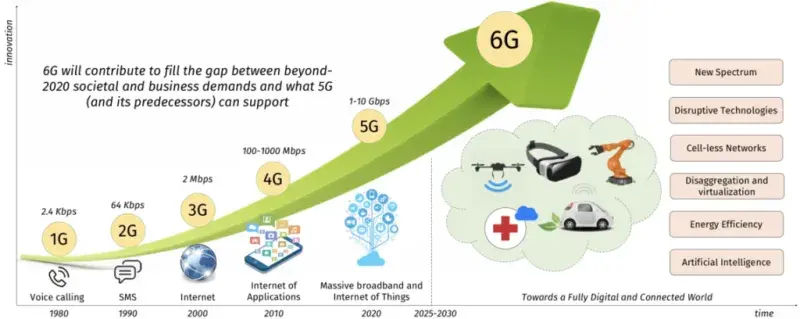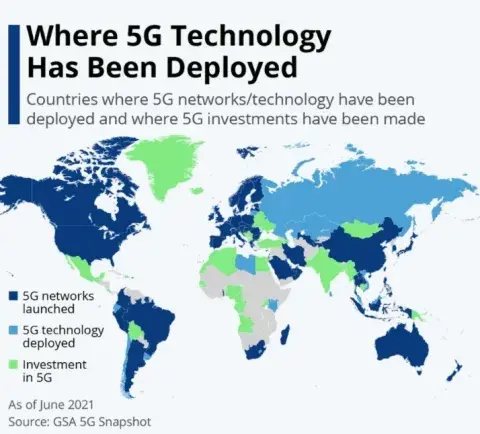Since the introduction of the first cellular network in the late 1970s, few, if any, technology areas have advanced as quickly as the mobile phone. In just 40 years, cellphones have gone from voice-only, analog devices plagued by poor connections and lax security to the high-powered computers that can connect people and places across the globe. While consumers are more focused on their immediate needs, researchers and telecommunications companies are already looking ahead to the next 40 years of innovation.
Taking a similar long view in the fast-paced technology world helps organizations and their leaders in government and in the private sector gain a clearer view of the future direction, uses, and even risks of soon-to-emerge technology.”
To that end, the Science and Technology Directorate (S&T) recently completed an in-depth study that gives interested stakeholders some insight into the ongoing rollout of fifth generation (5G) networking technologies and the early development of the sixth generation (6G).
Titled “5G: The Telecommunications Horizon and Homeland Security,” the report’s forward-looking scan uses the current state of 5G technology to preview the expected development of added enhancements like 5G Advanced and the next-generation 6G capabilities. More importantly, the report details relevant implications—opportunities, risks, and uncertainties—for the homeland and stakeholders across industry.
“Government and private-sector leaders should understand 5G’s current and expected impacts and how 6G is likely to develop if they want their organization to be poised to capitalize on each technology’s enhanced capabilities,” said Dr. Mark Fry, S&T’s senior tech scout. “This report provides insight on still-emerging 5G technology capabilities and opportunities, as well as the new capabilities that will be introduced by 6G. It is a must-read for leaders who think strategically about their organization’s future communications and connectivity capabilities.”

Opportunities, Risks and Uncertainties
The continuing development of 5G and the defining of next generation 6G networking technologies will introduce a range of opportunities to enhance the mission capabilities of DHS and the homeland security enterprise, as well as associated risks and uncertainties to consider. Following are capsules about each area.
Opportunities
The report notes that opportunities for DHS and other homeland security enterprise organizations include new and enhanced capabilities supported by 5G and 6G networking infrastructure that will enable an expansion of connected devices and the realization of the internet of things (IoT) on a massive scale. Combining the massive IoT edge computing capability with lower data latency and enhanced mobile broadband experience, 5G networks are rapidly paving the way for deployment of autonomous systems like reconnaissance drones and support the strengthening of the communications infrastructure, including systems used by first responders.
“The proliferation of millions of wireless sensors could accelerate DHS missions already supported by remote sensing, detecting, and tracking devices. Relevant use-cases include enhanced surveillance capabilities along U.S. borders, at government facilities, and in response to emergency events,” the report notes. “These capabilities all are enabled by 5G’s capacity to connect billions of communicating devices that could help make mission-focused IoT possible for DHS,” the entire homeland security enterprise and other government departments and agencies.
Turning to the expected benefits of 6G, the report notes that since significant bandwidth is needed to continuously collect and transmit information in a mobile network, the next-generation networking technology’s wider bandwidth could enable a complex sensing network to support DHS’ diverse missions at the border, at ports of entry, and in hazard detection, disaster alerts and responses, and many other use-cases.

Risks
As with most things in life, the good comes with the bad and organization leaders must consider how to address the downsides. In this case, the S&T horizon-scanning report notes the bad comes in the form of increased risks stemming from information and communications technology (ICT) supply chain vulnerabilities, an increased network attack surface stemming from mobile carriers’ adoption of Open Radio Access Network architecture, and an increasing reliance on mission-critical services supported by 5G and 6G infrastructure. Together these risks threaten homeland security, economic security, and other national and global interests that will continue to evolve through the transition to 6G, the report states.
For instance, undue influence from nation-states in standards development can negatively affect the competitive balance with the ICT market, potentially limiting the availability of trusted suppliers and leading to a situation where untrusted suppliers are the only market options.
Additionally, 5G networks are an attractive target for criminals and foreign adversaries to exploit for valuable information and intelligence and this weakness may become more acute with the deployment of 6G, the report states.
Uncertainties
A future-scan normally will include uncertainties and this report is no different. After all, not all aspects of future network technology are settled this far in advance, especially with 6G. As a result, uncertainties regarding 5G’s further development necessitate DHS, other government organizations and homeland security enterprise entities to consider how various scenarios will impact their mission over the next five to 10 years.
The future of 5G/6G network resiliency, security, and 6G standards development currently is uncertain and both factors face multiple potential scenarios that will be important for DHS and other organization leaders to monitor to inform future decision-making.
For instance, in a scenario where the U.S. leads development of 6G standards the effort will result in a global, unified standard that meets U.S. and other countries’ concerns for security standards and economic competitiveness, while enabling global market access to U.S. firms. However, if bifurcated 6G standards are created, where other countries create their own incompatible standards while the U.S. and its allies move forward with separate standards, a fragmented matrix of differing standards globally will result in operational and threat-based implications that U.S. organizations—government and private alike—will need to adapt to during deployment of 6G.
“The future of 5G and 6G networking technology will deliver capabilities to DHS and the homeland security enterprise for enhanced mission effectiveness, but their rollout is still in flux. Organizations must balance adoption of these capabilities against the risks and uncertainties in play with both technologies,” said Dr. Fry. “The S&T horizon scan will help organization leaders to create their roadmap for secure implementations of current 5G capabilities, future 5G enhancements, and 6G technologies.”
For more in-depth insight on the opportunities, risks, and uncertainties of 5G and 6G networking technology, visit S&T’s 5G/6G Horizon Scan page. Visit the Technology Scouting page for additional reports and information about S&T’s related processes. For media inquiries, contact [email protected].




